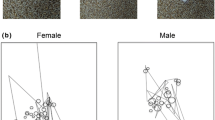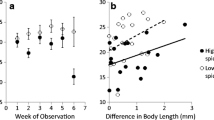Abstract
Gregarious animals often live in larger groups in food-rich environments. We compare cohesion and mobility of forest tent caterpillar (Malacosoma disstria) groups on high-quality (trembling aspen, Populus tremuloides) and low-quality (sugar maple, Acer saccharum) host trees. Following pheromone trails allows forest tent caterpillars to maintain group cohesion, but can cause groups to become trapped on poor-quality food sources. Trail-following decreases in food-deprived individuals. We combine laboratory and field experiments to show that this nutritionally mediated balance between trail fidelity and exploration generates fission-fusion dynamics, leading to increased mobility and smaller group sizes on poorer quality hosts. Indeed, caterpillar groups feeding on maple spent more time in locomotion, split into smaller groups, switched feeding site more frequently and traveled farther when compared to those feeding on aspen. These fission-fusion dynamics can be explained as an emergent property of individual responses to conspecifics: Individuals drift apart in contexts where responses to cues from conspecifics are weakened. Increased mobility appears as an adaptive response that improves the chances of relocating to a superior food source, but lower group size likely decreases thermoregulation and increases predation. Finally, we show that forest tent caterpillar fission-fusion dynamics not only control the spatial distribution of individuals in a tree, but they are also linked to considerable differences in growth and mortality and therefore can play an important role in population dynamics.
Significance statement
Many gregarious animals split up into smaller groups when food is scarce. In many species, the behaviors by which group members stay together and follow each other are well-understood; how then do these behaviors respond to changing conditions? In particular, how does hunger drive groups to split up in response to decreased food availability? We compare mobility and group size of forest tent caterpillar colonies on good- and poor-quality host plants. These caterpillars use pheromone trails to move around together, but when hungry, they tend to leave these trails. We show how caterpillars on a poor-quality host plant are not only more mobile (presumably an adaptive response that improves chances of discovering a better food source), but they also split into smaller groups—a side effect of decreased trail fidelity that possibly exposes them to greater risks.



Similar content being viewed by others
References
Addy ND (1969) Rearing the forest tent caterpillar on an artificial diet. J Econ Entomol 62:270–271. https://doi.org/10.1093/jee/62.1.270
Allen PE (2010) Group size effects on survivorship and adult development in the gregarious larvae of Euselasia chrysippe (Lepidoptera, Riodinidae). Insect Soc 57:99–204. https://doi.org/10.1007/s00040-010-0068-3
Bazazi S, Romanczuk P, Thomas S, Schimansky-Geier L, Hale JJ, Miller GA, Couzin ID (2011) Nutritional state and collective motion: from individuals to mass migration. Proc R Soc B Biol Sci 278:356–363. https://doi.org/10.1098/rspb.2010.1447
Colasurdo N, Dussutour A, Despland E (2007) Do food protein and carbohydrate content influence the pattern of feeding and the tendency to explore of forest tent caterpillars? J Insect Physiol 53:1160–1168. https://doi.org/10.1016/j.jinsphys.2007.06.004
Costa JT (2006) The other insect societies. Harvard University Press, Cambridge
Costa JT, Pierce NE (1997) Social evolution in the Lepidoptera: ecological context and communication in larval societies. In: The evolution of social behaviour in insects and arachnids. Cambridge University Press, Cambridge, pp 407–422
Costa JT, Ross KG (2003) Fitness effects of group merging in a social insect. Proc R Soc B Biol Sci 270:1697–1702. https://doi.org/10.1098/rspb.2003.2422
Despland E, Le Huu A (2007) Pros and cons of group living in the forest tent caterpillar: separating the roles of silk and of grouping. Entomol Exp Appl 122:181–189. https://doi.org/10.1111/j.1570-7458.2006.00512.x
Despland E, Gervais D, Morcos L (2017) Double allomimesis of advancing and retreating individuals maintains cohesion in exploring groups of nomadic caterpillars. Behav Ecol Sociobiol 71:56–65
Drouin J (2007) Le comportement alimentaire d’un herbivore généraliste (Malacasoma disstria HBN) sur des assemblages foliaires de peuplier et d’érable. Dissertation, Université de Québec à Montréal
Dussutour A, Simpson SJ, Despland E, Colasurdo N (2007) When the group denies individual nutritional wisdom. Anim Behav 74:931–939. https://doi.org/10.1016/j.anbehav.2006.12.022
Etilé E (2008) Comportement alimentaire de la livrée des forêts (Malacosoma disstria Hübner) sur quatre de ses plantes hôtes. Dissertation, Université de Québec à Montréal
Fortin M, Mauffette Y (2002) The suitability of leaves from different canopy layers for a generalist herbivore (Lepidoptera: Lasiocampidae) foraging on sugar maple. Can J For Res 32:379–389. https://doi.org/10.1139/x01-205
Fortin D, Fortin ME, Beyer HL, Duchesne T, Courant S, Dancose K (2009) Group-size-mediated habitat selection and group fusion–fission dynamics of bison under predation risk. Ecology 90:2480–2490. https://doi.org/10.1890/08-0345.1
Gerard JF, Bideau E, Maublanc ML, Loisel P, Marchal C (2002) Herd size in large herbivores: encoded in the individual or emergent? Biol Bull 202:275–282. https://doi.org/10.2307/1543479
Getz WM, Saltz D (2008) A framework for generating and analyzing movement paths on ecological landscapes. Proc Natl Acad Sci 105:19066–19071. https://doi.org/10.1073/pnas.0801732105
Grisdale D (1985) Malacosoma disstria. In: Handbook of insect rearing. Elsevier, Amsterdam, pp 369–379
Haydon DT, Morales JM, Yott A, Jenkins DA, Rosatte R, Fryxell JM (2008) Socially informed random walks: incorporating group dynamics into models of population spread and growth. Proc R Soc B Biol Sci 275:1101–1109. https://doi.org/10.1098/rspb.2007.1688
Krause J, Ruxton GD (2002) Living in groups. Oxford University Press, New York
Kummer H (1971) Primate societies; group techniques of ecological adaptation. Aldine-Atherton, Chicago
Levesque KR, Fortin M, Mauffette Y (2002) Temperature and food quality effects on growth, consumption and post-ingestive utilization efficiencies of the forest tent caterpillar Malacosoma disstria (Lepidoptera: Lasiocampidae). Bull Entomol Res 92. https://doi.org/10.1079/BER2002153
Marino A, Baldi R (2014) Ecological correlates of group-size variation in a resource-defense ungulate, the sedentary guanaco. PLoS One 9:e89060. https://doi.org/10.1371/journal.pone.0089060
McClure M, Despland E (2010) Collective foraging patterns of field colonies of Malacosoma disstria caterpillars. Can Entomol 142:473–480. https://doi.org/10.4039/n10-001
McClure M, Despland E (2011) Defensive responses by a social caterpillar are tailored to different predators and change with larval instar and group size. Naturwissenschaften 98:425–434. https://doi.org/10.1007/s00114-011-0788-x
McClure M, Cannell E, Despland E (2011) Thermal ecology and behaviour of the nomadic social forager Malacosoma disstria. Physiol Entomol 36:120–127. https://doi.org/10.1111/j.1365-3032.2010.00770.x
McClure M, Morcos L, Despland E (2013) Collective choice of a higher-protein food source by gregarious caterpillars occurs through differences in exploration. Behav Ecol 24:113–118. https://doi.org/10.1093/beheco/ars141
McMillen JD, Wagner MR (1998) Influence of host plant vs. natural enemies on the spatial distribution of a pine sawfly, Neodiprion autumnalis. Ecol Entomol 23:397–408
Peters MI, Despland E (2006) Plasticity in forest tent caterpillar collective foraging schedules. Ethology 112:521–528. https://doi.org/10.1111/j.1439-0310.2005.01197.x
Pimentel C, Santos M, Ferreira C, J-åKe N (2012) Temperature, size, reproductive allocation, and life-history evolution in a gregarious caterpillar. Biol J Linn Soc 105:340–349. https://doi.org/10.1111/j.1095-8312.2011.01794.x
Portha S, Deneubourg JL, Detrain C (2002) Self-organized asymmetries in ant foraging: a functional response to food type and colony needs. Behav Ecol 13:776–781. https://doi.org/10.1093/beheco/13.6.776
Prokopy RJ, Roitberg BD (2001) Joining and avoidance behavior in nonsocial insects. Annu Rev Entomol 46:631–635
Robison DJ (1993) The feeding ecology of the forest tent caterpillar, Malacosoma Disstria Hubner, among hybrid poplar clones, Populus Ssp. Madison. University of Wisconsin, Wisconsin
Santana AFK, McClure M, Ethier J, Despland E (2015) Exploration costs promote conservative collective foraging in the social caterpillar Malacosoma disstria. Anim Behav 105:245–250. https://doi.org/10.1016/j.anbehav.2015.04.022
Tinbergen N (1963) On aims and methods of ethology. Z Tierpsychol 20:410–433. https://doi.org/10.1111/j.1439-0310.1963.tb01161.x
Ward A, Webster M (2016) Sociality: the behaviour of group-living animals. Springer International Publishing, Cham
Warton DI, Hui FKC (2011) The arcsine is asinine: the analysis of proportions in ecology. Ecology 92:3–10. https://doi.org/10.1890/10-0340.1
Acknowledgements
We thank Jackie Peters for assisting with field work, the Morgan Arboretum staff for use of their facilities, and the Ministry of Natural Resources and Forestry of Ontario for supplying egg masses.
Funding
This work was supported by a Natural Sciences and Engineering Research Council of Canada (NSERC) Discovery grant (no. 250173) to E.D. The experiments comply with the current laws of the country in which they were performed.
Author information
Authors and Affiliations
Corresponding author
Additional information
Communicated by J. C. Choe
Rights and permissions
About this article
Cite this article
Plenzich, C., Despland, E. Host-plant mediated effects on group cohesion and mobility in a nomadic gregarious caterpillar. Behav Ecol Sociobiol 72, 71 (2018). https://doi.org/10.1007/s00265-018-2482-x
Received:
Revised:
Accepted:
Published:
DOI: https://doi.org/10.1007/s00265-018-2482-x




